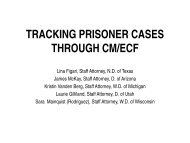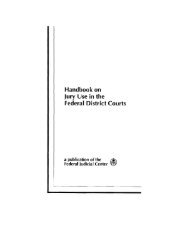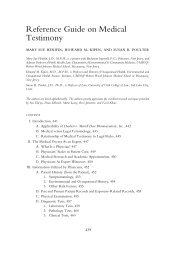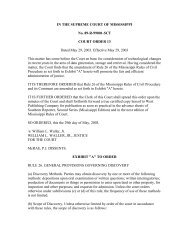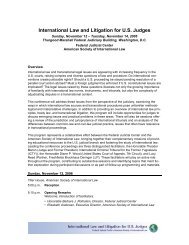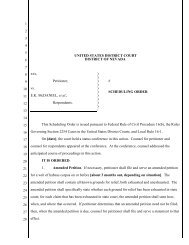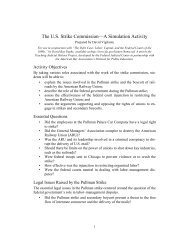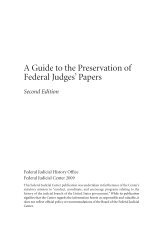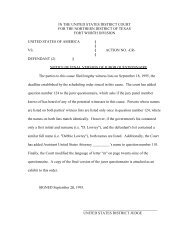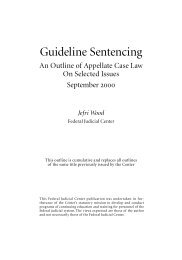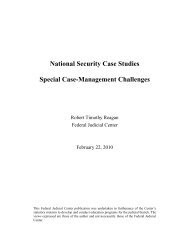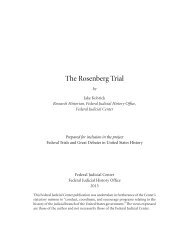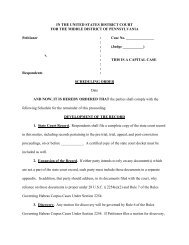Federal Court Decisions Involving Electronic Discovery, December 1 ...
Federal Court Decisions Involving Electronic Discovery, December 1 ...
Federal Court Decisions Involving Electronic Discovery, December 1 ...
You also want an ePaper? Increase the reach of your titles
YUMPU automatically turns print PDFs into web optimized ePapers that Google loves.
<strong>Federal</strong> E-<strong>Discovery</strong> <strong>Decisions</strong>, <strong>December</strong> 1, 2006 – July 31, 2009<br />
the agreed-upon terms of various insurance policies. The agent originally claimed that the<br />
laptop computer had been damaged by lightening and taken to a technician who could not<br />
repair it and disposed of it. When confronted with a statement from the technician who<br />
claimed that it was repaired and returned to the agent, the agent changed his testimony to<br />
say that the laptop malfunctioned again a few days after he received it from the<br />
technician and he disposed of it. Finding that the defendant had a clear duty to preserve<br />
the hard drive of the laptop whether or not it was in working order, the court allowed the<br />
plaintiff to inform the jury of the defendant’s actions and reduced the plaintiff’s burden of<br />
proof in establishing the disputed terms of the insurance policies.<br />
Green v. Fluor Corp., 2009 WL 1668376 (M.D. La. June 11, 2009). After reviewing a<br />
camera phone photograph obtained through discovery, the requesting party sought access<br />
to the producing party’s entire phone and email account, arguing the original photograph<br />
was of poor quality. The court denied the motion, citing the requesting party’s failure to<br />
initially exert its right under Rule 34(b)(1)(C) to request the particular form of<br />
production, thus leaving the decision to the other party. And while the requesting party<br />
contended the image was of poor quality, the court noted that it did not attach a copy of<br />
the photograph to its motion for review. The court held that under Rule 34(b)(2)(E)(iii) a<br />
party is not obligated to produce the same ESI in more than one form.<br />
Greyhound Lines, Inc. v. Wade, 485 F. 3d 1032 (8th Cir. 2007). In this tort case<br />
involving a Greyhound bus and a commercial delivery vehicle, the plaintiff moved for<br />
sanctions against the defendant for failing to preserve the electronic control module<br />
(ECM) data in anticipation of litigation. The court, relying heavily on Morris v. Union<br />
Pac. R.R., 373 F.3d 896 (8th Cir. 2004), explained that “the ultimate focus for imposing<br />
sanctions for spoliation of evidence is the intentional destruction of evidence indicating a<br />
desire to suppress the truth, not the prospect of litigation.” Morris at 902. Finding no<br />
evidence of prejudice or bad intent, the appellate court affirmed the district court’s ruling<br />
that spoliation sanctions were not appropriate.<br />
Grider, et al. v. Keystone Health Plan Central, 2007 U.S. Dist. LEXIS 73066 (E.D.<br />
Pa. Sept. 28, 2007). In a class action suit against a managed health care plan, the<br />
plaintiffs moved for sanctions against the defendant, claiming three years of discovery<br />
obstruction and last-minute production of paper and ESI that the defendants had<br />
previously claimed did not exist. The court imposed monetary sanctions totally $5<br />
million on both the defendants and their counsel. (As of this writing, this decision is on<br />
appeal to the Third Circuit.)<br />
Gronchocinski v. Schlossburg, 2009 U.S. Dist. LEXIS 19523 (N.D. Ill. Mar. 11,<br />
2009). In a bankruptcy court proceeding arising out of fraudulent transfers of realty, the<br />
defendant received a preservation demand from the trustee while a motion to allow<br />
access to the defendant’s computer system was pending. The defendant then installed a<br />
disk cleaning system, destroyed over 16,000 files by overwriting ESI, and installed a<br />
program to verify the integrity of the destruction. The bankruptcy court entered default<br />
judgment and sanctions against the defendant. On appeal, the district court affirmed,<br />
Copyright © 2009, The Sedona Conference ® 37<br />
www.thesedonaconference.org



